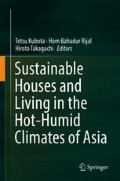Abstract
Two surveys of the thermal environment and thermal sensations were conducted in the indoor and the semi-open spaces of traditional houses, during both summer and winter, in five districts of Nepal: Banke, Bhaktapur, Dhading, Kaski, and Solukhumbu. The surveys were carried out for 40 days, gathering a total of 7116 thermal sensations from 103 subjects. The results show that residents are highly satisfied with the thermal condition of their houses. The residents have higher comfort temperatures in semi-open spaces such as verandas than in indoor spaces. The findings reveal that people in the regions studied adapt well to the natural environment, as a result of which comfort temperatures are different in different climates. They are lowest in the cool climate, medium in the temperate climate, and highest in the subtropical climate. By using the relationship between indoors and outdoors, the adaptive model for dwellings was proposed to predict the comfort temperature.
Access this chapter
Tax calculation will be finalised at checkout
Purchases are for personal use only
References
Rijal HB, Yoshida H, Umemiya N (2002) Investigation of the thermal comfort in Nepal. In: Proceedings of international symposium on building research and the sustainability of the built environment in the tropics, pp 243–262
Rijal HB, Yoshida H, Umemiya N (2003) Summer and winter thermal comfort of Nepalese in houses. J Archit Plann Environ Eng AIJ 68(565):17–24 (in Japanese with English abstract)
Rijal HB, Yoshida H, Umemiya N (2010) Seasonal and regional differences in neutral temperatures in Nepalese traditional vernacular houses. Build Environ 45(12):2743–2753
Rijal HB, Yoshida H (2002) Investigation and evaluation of firewood consumption in traditional houses in Nepal. In: Proceedings of the 9th international conference on indoor air quality and climate, vol 4. pp 1000–1005
Rijal HB, Yoshida H (2002) Comparison of summer and winter thermal environment in traditional vernacular houses in several areas of Nepal. Adv Build Technol 2(2):1359–1366
Rijal HB, Yoshida H (2006) Winter thermal comfort of residents in the Himalaya region of Nepal. In: Proceedings of international conference on comfort and energy use in buildings – getting them right (Windsor), Organised by the Network for Comfort and Energy Use in Buildings, Number of Pages: 15
Nakamura Y, Okamura K (1997) Analysis for appearance of seasonal acclimatization in optimum temperature based on some field investigations. J Archit Plann Environ Eng AIJ 495:85–91 (in Japanese with English abstract)
Iseki K, Isoda N, Yanase T, Hanaoka T (1988) A survey of residential thermal environments (Part 2): effect of thermal conditions on the residents. J Home Econ Jpn 19(8):879–884 (in Japanese with English abstract)
Nicol F, Jamy GN, Sykes O, Humphreys M, Roaf S, Hancock M (1994) A survey of thermal comfort in Pakistan toward new indoor temperature standards. Oxford Brookes University, School of Architecture, Oxford
Kato T, Yamagishi A, Yamashita Y (1996) Difference between winter and summer of the indoor thermal environment and residents’ thinking of detached houses in Nagano city. J Archit Plann Environ Eng AI J 481:23–31 (in Japanese with English abstract)
Sawachi T, Matsuo Y (1989) Daily cycles of activities in dwellings, in the case of housewives: study on residents’ behavior contributing to formation of indoor climate, Part 2. J Archit Plann Environ Eng AIJ 398:35–46 (in Japanese with English abstract)
Sawachi T, Matsuo Y, Hatano K, Fukushima H (1987) Determinants of heating and air conditioning behavior and acceptable ranges of temperature based on behavior: Study on residents’ behavior contributing to formation of indoor climate, Part 1. J Archit Plann Environ Eng AIJ 382:48–59 (in Japanese with English abstract)
Humphreys MA, Rijal HB, Nicol JF (2013) Updating the adaptive relation between climate and comfort indoors; new insights and an extended database. Build Environ 63(5):40–55
Comité Européen de Normalisation (CEN) (2007) EN 15251: indoor environmental input parameters for design and assessment of energy performance of buildings addressing indoor air quality, thermal environment, lighting and acoustics. CEN, Brussels
Acknowledgments
We would like to give thanks to Prof. Harunori Yoshida, Prof. Noriko Umemiya, Prof. Michael Humphreys, and Prof. Fergus Nicol for their research guidance, to the investigated households for their cooperation, and to our families and friends for their support. This research is supported by the Japan Society for the Promotion of Science.
Author information
Authors and Affiliations
Corresponding author
Editor information
Editors and Affiliations
Rights and permissions
Copyright information
© 2018 Springer Nature Singapore Pte Ltd.
About this chapter
Cite this chapter
Rijal, H.B. (2018). Comfort Temperature and Adaptive Model in Traditional Houses of Nepal. In: Kubota, T., Rijal, H., Takaguchi, H. (eds) Sustainable Houses and Living in the Hot-Humid Climates of Asia. Springer, Singapore. https://doi.org/10.1007/978-981-10-8465-2_17
Download citation
DOI: https://doi.org/10.1007/978-981-10-8465-2_17
Published:
Publisher Name: Springer, Singapore
Print ISBN: 978-981-10-8464-5
Online ISBN: 978-981-10-8465-2
eBook Packages: Earth and Environmental ScienceEarth and Environmental Science (R0)

